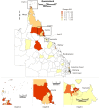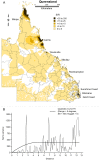Spatial and temporal patterns of locally-acquired dengue transmission in northern Queensland, Australia, 1993-2012
- PMID: 24691549
- PMCID: PMC3972162
- DOI: 10.1371/journal.pone.0092524
Spatial and temporal patterns of locally-acquired dengue transmission in northern Queensland, Australia, 1993-2012
Abstract
Background: Dengue has been a major public health concern in Australia since it re-emerged in Queensland in 1992-1993. We explored spatio-temporal characteristics of locally-acquired dengue cases in northern tropical Queensland, Australia during the period 1993-2012.
Methods: Locally-acquired notified cases of dengue were collected for northern tropical Queensland from 1993 to 2012. Descriptive spatial and temporal analyses were conducted using geographic information system tools and geostatistical techniques.
Results: 2,398 locally-acquired dengue cases were recorded in northern tropical Queensland during the study period. The areas affected by the dengue cases exhibited spatial and temporal variation over the study period. Notified cases of dengue occurred more frequently in autumn. Mapping of dengue by statistical local areas (census units) reveals the presence of substantial spatio-temporal variation over time and place. Statistically significant differences in dengue incidence rates among males and females (with more cases in females) (χ(2) = 15.17, d.f. = 1, p<0.01). Differences were observed among age groups, but these were not statistically significant. There was a significant positive spatial autocorrelation of dengue incidence for the four sub-periods, with the Moran's I statistic ranging from 0.011 to 0.463 (p<0.01). Semi-variogram analysis and smoothed maps created from interpolation techniques indicate that the pattern of spatial autocorrelation was not homogeneous across the northern Queensland.
Conclusions: Tropical areas are potential high-risk areas for mosquito-borne diseases such as dengue. This study demonstrated that the locally-acquired dengue cases have exhibited a spatial and temporal variation over the past twenty years in northern tropical Queensland, Australia. Therefore, this study provides an impetus for further investigation of clusters and risk factors in these high-risk areas.
Conflict of interest statement
Figures







References
-
- WHO (2013) Dengue - Neglected tropical diseases research Available: http://www.who.int/tdr/research/ntd/dengue/en/index.html. Accessed 6 February, 2013.
-
- Russell RCCB, Lindsay MD, Mackenzie JS, Ritchie SA, Whelan PI (2009) Dengue and climate change in Australia: predictions for the future should incorporate knowledge from the past. Med J Aust 190: 265–268. - PubMed
-
- Tsuzuki AVT, Higa Y, Nguyen TY, Takagi M (2009) Effect of peridomestic environments on repeated infestation by preadult Aedes aegypti in urban premises in Nha Trang City, Vietnam. Am J Trop Med Hyg 81: 645–650. - PubMed
-
- Queensland Health. (2013) Dengue fever. Available: http://www.health.qld.gov.au/dengue/outbreaks/current.asp. Accessed 20 January, 2013.
Publication types
MeSH terms
LinkOut - more resources
Full Text Sources
Other Literature Sources
Medical
Miscellaneous

